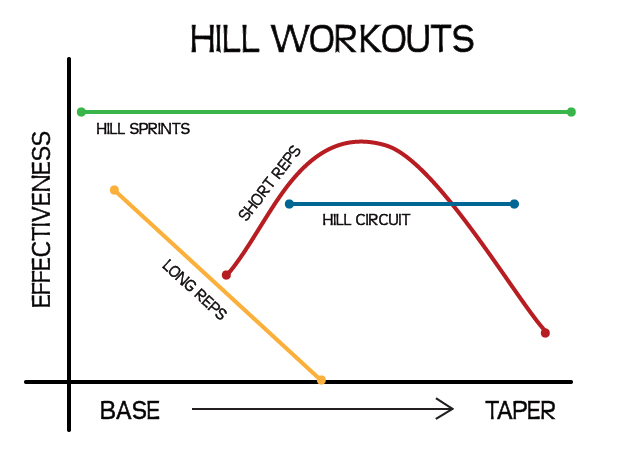Hill workouts are the unsung hero of speed work. Any runner can do them – and every runner will benefit.

Throughout my running career, hills have been used strategically in many types of workouts.
In high school, we ran hill repetitions and circuits. Sometimes, we ran them before or after other types of fast work (diabolical!).
In college, we ran similar workouts but added long repetitions and reps with “cruise recoveries” (in other words, even the recovery was run at a quicker pace).
Those were brutal…
And tellingly, we ran hill workouts during every season: summer base training, cross country, indoor track and the spring outdoor track season.
If the goal race was 10k or 800m, hill workouts were on the schedule.
That shouldn’t be surprising. Frank Shorter famously said, “Hills are speedwork in disguise.”
But I think my favorite sentiment about hills comes from this anonymous quote:
Most of us try to avoid hills, but what’s so good about that?
Think about it: flat tires, flat hair, flat returns, and the ultimate – flatlining.
Life happens on the hills. They’re opportunities to prove to yourself that you’re stronger than you ever imagined.
If you never attempt the ascent, you’ll never know the thrill of swooshing down the other side.
Hill workouts are hard and unpleasant. They challenge your endurance, speed, and strength.
There’s no other workout like hills.
And that’s just why they’re so valuable.
Why Are Hill Workouts so Beneficial?
Running uphill (against gravity) stresses your body in a unique way that you can’t mimic on flat land.
That stress results in some fantastic adaptations and benefits:
- There’s less impact running uphill so it’s easier on your joints and connective tissues
- Hills “force” you to run with better form, reinforcing a more efficient stride
- Running up steep grades builds power more safely than running fast on flat terrain
- Hills provide the most specific strength work runners could ask for
- Hill workouts build strength, speed, endurance, VO2 Max, and every other metric runners care about!
While hill sessions aren’t too race-specific (unless you’re training for an entirely uphill race), they have a valuable place in any training program.
And since they’re so versatile, they can be used at any time during the season – the early base training phase, the middle competition period, or even late in the season during the taper.
It all depends on how the hill workout is completed.
When Should Hills Be Used In Training?
ALL DAY EVERY DAY. NO EXCUSES.
Ok ok, I got carried away. I just really like hills. Let’s take a look at this graphic for a better visual:

To recap:
- Hill sprints: outstanding workout that can be done anytime during a training season. They’re very effective at accomplishing their goals.
- Short reps: very helpful workout best done in the mid or later stages of a training cycle.
- Long reps: Best done during the earlier phases of training, but can be done (less effectively) during the middle stages of training
- Hill circuits: a good workout for the middle or later phases of the training cycle. Not my preferred type of workout though
Pay less attention to the y-axis – the “Effectiveness” of the workout. All are effective, just at different things (i.e., hill sprints are great for neuromuscular training but long reps are better for aerobic fitness).
The real measure of a workout’s value is in how it’s used, when it occurs, and the workouts that come before and after them in the entire progression.
Let’s look at some types of hill workouts and how to best implement them in your training plan.
Hill Workout #1: Short Reps
Short hill repetitions are the traditional workout that most of us think of when we envision a hill workout.
They’re usually 60-90 seconds in length with a jog down recovery (you turn around at the end of the rep and run easy down to the bottom before turning around to start again).
They’re usually done at about 3k-10k pace on a 4-7% grade hill. In other words, they’re short and fast!
They’re a classic VO2 Max workout, helping the body increase its ability to deliver and process oxygen to hard-working muscles.
But there’s also a significant strength aspect, making this a great workout for those who struggle with injuries.
Here are a few examples of short hill rep workouts:
- 10 x 90sec hills at 5k Pace
- 8 x 60sec hills at 3k Pace
- Descending ladder: 3x90sec, 3x60sec, 3x45sec starting at 10k Pace and getting progressively faster
There’s a lot of flexibility in designing short hill rep workouts. Vary the pace, length of rep, and number of reps to suit your needs.
These hill workouts are best incorporated into the middle or late stages of a running season as you’re focusing more on power and speed.
But of course, like most things in running, there are exceptions. If the reps are shorter, with longer recoveries, they can be used in the early phases of training as a precursor to more challenging workouts.
Hill Workout #2: Long Reps
Long reps of 2-4 minutes hold a dear place in my memory: I’m terrified of them.
Once per season during college cross country, my coach had us run 5 x 3min hills with a jog down recovery. The pace was hard and the undulating terrain made them particularly challenging.
Thinking of that workout – “We’re going to Pig Hill today” – still makes me nervous 12 years after my last Pig Hill workout. While they weren’t as intense as short reps, they seemed more challenging mentally because of their length.
These types of hill workouts can be used for a variety of reasons:
- Early strength-building during the base phase of training
- A type of tempo workout (if the pace is kept under control)
- A replacement for shorter hill reps if an easier day is needed
Since a slower, but longer hill workout like this is more aerobic, it’s best used in the earlier phases of training.
Hill Workout #3: Circuit
Hill circuits are usually the most challenging of any type of hill workout because the recovery jog is done at a faster pace.
This reduces the amount that you’re able to recover between repetitions and makes the workout more aerobically demanding.
Here are a few examples:
- 8 x 90sec hills at 5k effort, jog down recovery at marathon effort
- 8 x 45sec hills at 3k effort, jog down recovery at 10k/half marathon effort
These sessions are similar to track workouts with “cruise recoveries” where the rest period is run at a more challenging pace.
Because the recovery is demanding and the pace of these reps is fast, it’s best to use these workouts in the middle or later stages of a season when the goal race is at the half marathon or shorter distance.
The harder the workout, the more appropriate it is for the later stages of a training cycle because it will get you into peak shape sooner.
And you can only maintain peak shape for a brief 6-8 week window in most cases.
Bonus Workout: Hill Sprints
I’m including hill sprints in this post – even though I don’t consider them a “workout.”
Like strides, hill sprints are more like drills that you do after a run. They’re only 8-10 seconds, but these short, max-intensity sprints up the steepest hill you can find pack a powerful punch.
Because the hill is so steep – and the pace is literally as fast as you can go – they recruit as many muscle fibers as possible, helping you:
- Increase stride power
- Engage more muscle fibers
- Improve running economy
- Strengthens muscles and connective tissues (helping with injury prevention)
If you’re injury-prone, they should be a regular addition to your program. Here’s more info on hill sprints or check out this video demonstration:
Note the recovery: it’s just walking! I take my sweet time between reps since this is a speed development workout.
What if You Don’t Have Hills?
Hill training without the hills can be challenging. But there are certainly ways that you can mimic the training effect of hills.
First, watch our hill training without hills video on YouTube:
In addition to these ideas, the most basic is to run your hill workouts on a treadmill.
Follow these basic rules to get the most from treadmill hill sessions:
- Run a thorough warmup before any workout (hills or otherwise)
- Hill reps can be run on grade of 3-7% depending on the type of workout (see above!)
- Take 2-4 minutes of recovery on a flat incline at an easy effort in between reps
With a combination of high mileage, strength training, and treadmill sessions, you can get all the benefits of hills.
Who Should Run Hill Sessions?
Short answer: everyone!
Every runner stands to benefit from the power, speed, and strength gained from structured hill workouts.
But there are a few key groups of people who will reap disproportionate rewards from hills.
If you’re injury-prone, hills are a safer alternative to road or track workouts because there’s less impact force distributed throughout your legs.
They also reinforce proper running form. It’s more challenging to over-stride or have poor posture while running uphill.
Finally, hill workouts build very running-specific strength. It takes a strong runner – both muscularly and aerobically – to run quickly up a steep hill.
And stronger, more economical runners are always less prone to running injuries.
If you’re a new runner, hills build more skill and power (which are not common facets of fitness that beginner runners typically focus on during training).
The exception here is if you’re still in the first few weeks of your running journey. With such a low training age, it’s best to focus on hill sprints and running hills at your easy pace on a regular run.
If you’re training for a hilly race, it’s clearly important to build some hills into your training program.
While hill repetitions are not the most race-specific type of workout, they do build the power and strength to be successful on hilly race courses.
And it’s important not to discount the psychological benefits of being comfortable on hills. Without practice, a hilly course might seem overly daunting on race day.
You can also check out even more hill workouts in my book, 52 Workouts, 52 Weeks, One Faster Runner.
Your turn: What types of hill workouts do you run? Do you structure them differently?
Let us know in the comments below – I’d love to learn more about how you use hills in your training.